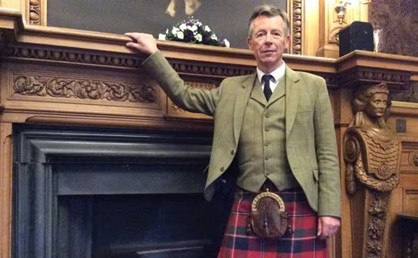Press Release for TARTAN DAY (April 6th, 2025)
“The Search for a Tartan”
From 1757 to 1763 three Highland (Scottish) regiments served in the Seven Years’ War. After the Treaty of Paris numerous Gaelic speaking Highlanders took their discharge and remained in North America. Many from the 78th Regiment of Foot (Fraser’s Highlanders) remained in former Nouvelle France and married French Canadian women. They settled throughout Quebec and their now French speaking descendants are amongst us. Are you one of them? If you are, do you have a piece of tartan material long buried away?
In 2022, Peter Eslea MacDonald conducted a journey through the maritime provinces to search for old tartan material which he wished to date. Thirty years earlier he had found a piece of tartan material with a unique weave, one which no longer existed in Scotland.
MacDonald is a “Tartan Historian” and the head of research for the Scottish Tartan Authority. He is a world expert in identifying tartan materials, dating them, and has worked with the oldest tartans available.
His search was to find a piece of “Government set” more popularly known as the “Black Watch” tartan. The three regiments of soldiers who remained in North America would have worn that tartan: the Royal Highland Regiment (Black Watch), Montgomery’s Highlanders, and Fraser’s Highlanders. The Frasers were disbanded in December 1763 and over 150 oficers and soldiers remained, mostly in Quebec. As oficers were required to purchase their own uniforms, and were not required to adhere to government clothing regulations, some historians believe that Fraser’s oficers may have worn a red-based tartan.
More Highland regiments served during the American Revolutionary War (1775–1787) and the “Royal Highland Emigrants,” a locally raised provincial regiment, also wore the Black Watch tartan. The battalion that was raised in Quebec and New York also had many French Canadians wearing kilts in their ranks. The regiment defended Quebec City during the failed 1775 attack by American rebel forces under General Richard Montgomery and Colonel Benedict Arnold. For the first time, French, English and Gaelic speaking Canadians stood shoulder to shoulder to defend their country from invaders. As Peter MacDonald explained:
“The Black Watch tartan is the oldest military tartan; it was used by them and a number of other regiments in the 18th century. I calculate that some forty miles (65 Kms) of the tartan was woven between the founding of the Black Watch regiment and the end of the American War of Independence but not one piece is known to survive. Given the amount woven, and the fact that a lot of soldiers settled in North America, particularly Canada, I feel sure that there must be a piece somewhere in a family collection. It is possible that they have an old piece of tartan and don’t realise the significance. Finding an original piece is my Tartan Holy Grail and I would love to hear from anyone that might have something they think could be it.”
MacDonald is still searching for that one piece of fabric “The Holy Grail” that will solve what the tartan looked like. It would also answer the question of which tartan the Fraser Highlanders wore.
Ewen Booth, a local researcher from Montmagny, Quebec, stumbled upon MacDonald’s article and felt that this should be sent throughout Quebec to the French speaking population. Booth has been researching the first Scottish people who settled in Quebec after 1763 for the last nine years. He has the genealogy of many French Canadians with Scottish roots. It is hoped that somewhere between Montreal and Gaspe there may be a blanket, a family heirloom, a kilt, or some old piece of cloth that has been tucked away for years. Booth wishes to assist MacDonald in his research and will be the local contact in Canada.
Booth’s own interest is that his wife, Kathleen McKen, a French speaking Quebecker, is descended from at least three of these Scottish soldiers and they live in the 1767 home of one, her great uncle, Donald McKinnon, who lived there prior to becoming the second Seigneur in Matane (“Maison McKinnon” in Montmagny.) Her own Great-Grandfather, another Donald McKinnon, settling in Berthier-Sur-Mer. Booth is a former member of both the Black Watch of Canada and the modern-day 78th Fraser Highlanders, and his father served in the Black Watch in Scotland.
Photo supplied by P eter Eslea MacDonald
« Le Chardon et la Fleur de Lys »
English: Ewen Booth French : Kathleen McKen
Northernpiper@outlook.com Kathleenmcken@hotmail.com
514-966-0205 450-613-0433
